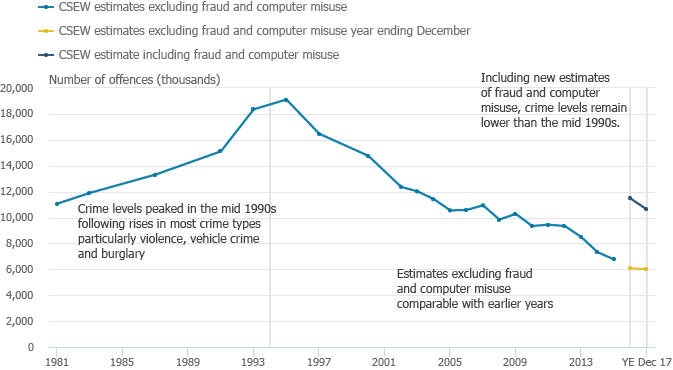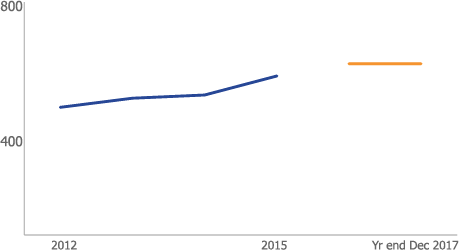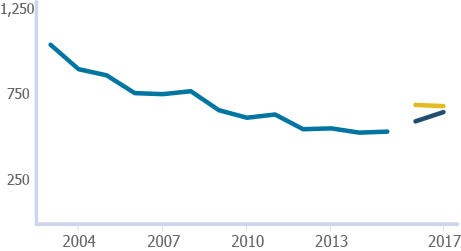Crime overview: year ending December 2017
Crimes against households, adults, children, businesses and society in England and Wales.
This page is part of the latest crime collection
Over the long-term, crime has fallen, but some crimes have risen slightly in the previous 12 months
England and Wales, year ending December 1981 to year ending December 2017

Source: Crime Survey for England and Wales, Office for National Statistics
- Crimes involving knives or other sharp instruments rose 26% from 32,468 to 39,598.
- Robbery has increased 33% from 55,892 to 74,130.
- 8 in 10 people were not a victim of crime in the previous 12 months.
On this page:
- Analysis of crime
- Crime data
- How do we measure this?
- What do you need to know?
- Glossary
- More pages in this collection
- More about crime
- Contact us
Pages in this collection:
Crime overall has fallen in the last year
Crime estimated by the Crime Survey for England and Wales (CSEW) shows crime overall has fallen in the last year, driven by a 28% decline in computer misuse.
Most individual types of crime, including violence, have stayed at levels similar to the previous year.
When looking at the main types of crime, changes were only seen in:
- computer misuse offences (28% decrease to 1.37 million offences), which drove the fall in overall CSEW crime
- vehicle-related thefts (17% increase to 929,000 offences)
The increase in vehicle-related thefts is supported by a 16% increase in vehicle offences recorded by the police to 452,683 offences; a category that is well reported to the police and thought to be well recorded.
All other main types of crime measured by the survey showed no change.
Police recorded rises in knife and gun crime, mainly in large cities
Police recorded crime data showed evidence of rises in some other categories of crime, particularly the more harmful, less frequently-occurring offences.
The police figures indicate rises in the following types of crime:
- offences involving knives or sharp instrument (up 22% to 39,598 recorded offences)
- offences involving firearms (up 11% to 6,604 recorded offences)
These offences tend to be disproportionately concentrated in London and other metropolitan areas; however, the majority of police force areas saw rises in these types of violent crime.
More homicides, burglaries and robberies reported
Latest police recorded figures showed rises in:
- burglary, which increased by 9% (up to 438,971 offences)
- robbery (up 33% to 74,130 offences)
- homicides (up 9% to 653 offences)
Latest police recorded figures show a 9% increase on the previous year.
This continues an upward trend seen in homicides since March 2014, indicating a change to the long-term fall seen in the previous decade.
These figures exclude the London and Manchester terrorist attacks in 2017. They also exclude the 96 cases of manslaughter from the Hillsborough disaster which were recorded in 2016.
Likelihood of being a victim has fallen considerably
Around 4 in 10 adults were estimated to have been a victim of crime in 1995; before the survey included fraud and computer misuse in its coverage.
In the year ending December 2017, just over 1 in 10 adults were a victim of crimes comparable with those measured in the 1995 survey.
Including fraud and computer misuse, 2 in 10 adults were a victim of crime in the year ending December 2017.
Crime data
This page mainly reports on data from the Crime Survey for England and Wales (CSEW) and police recorded crime.
More information on both these sources can be found in the User guide to crime statistics for England and Wales.
Using crime data
More pages in this collection

Weapons crimes
Police recorded 7,130 (22%) more crimes involving weapons, with knife crime in cities rising most.
Released: 26 April 2018
More about crime
-
ONS Focus on Violent Crime and Sexual Offences: Year ending March 2015
The Homicide chapter contains analysis, long-term trends and the circumstances of violence, based on the Home Office Homicide Index.
-
The nature of violent crime in England and Wales: year ending March 2017
Long-term trends and the circumstances of violence (does not include the most recent statistics for the year ending December 2017).
-
Overview of fraud and computer misuse statistics
Summary of the various sources of data for fraud and computer misuse and what these tell us about victims, circumstances and long-term trends.
Contact us
Mark Bangs
crimestatistics@ons.gov.uk
+44 (0)2075 928689




